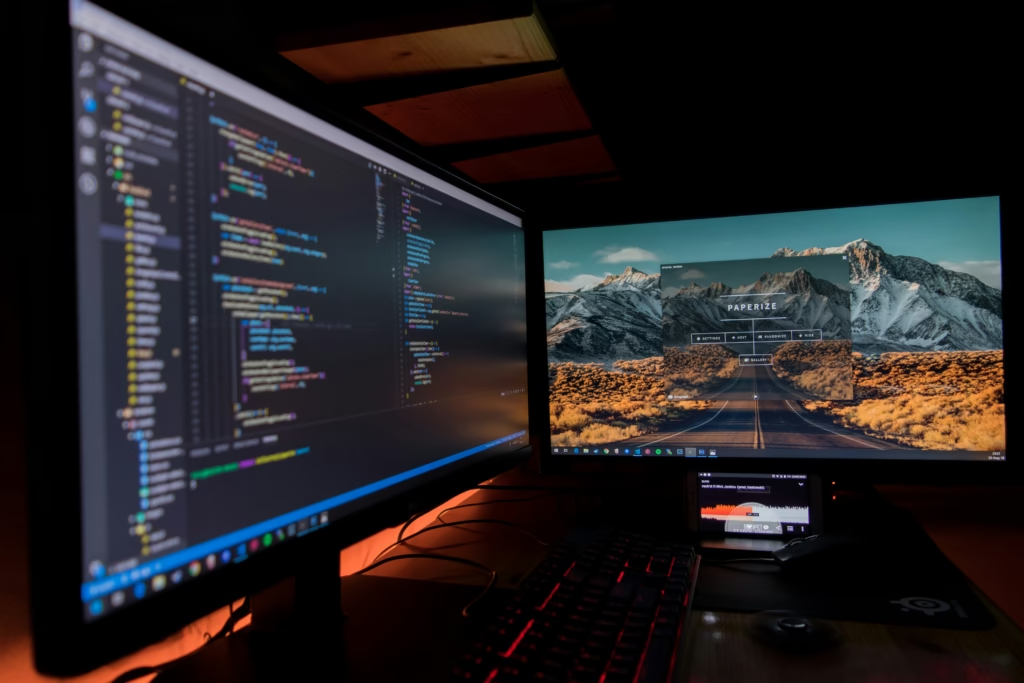Do Dual Monitors Really Improve Productivity? My Setup Tested

My coworker wouldn’t shut up about his dual monitor setup. “Dude, it’s like having superpowers,” he’d say. I rolled my eyes. I’m fast with Alt+Tab, thanks. Then I had three research papers due in one week. Trying to juggle 15 browser tabs, two Word docs, and a spreadsheet on one screen nearly broke my brain. That’s when I finally wondered: do dual monitors really improve productivity?
I bought a second monitor and tested it for a month. Turns out my annoying coworker was right.
What Actually Changed
The biggest difference wasn’t more space—it was less clicking around like a maniac. Before, I’d write a paragraph, switch to my research tab, lose my spot, get distracted by YouTube, forget what I was looking for. Classic.
With dual monitor productivity, I just kept research on the left and writing on the right. Boom. No more losing my train of thought every five seconds.
Multi-screen efficiency was huge during Zoom calls. Having the meeting on one screen while taking notes on the other meant I could actually participate instead of frantically switching windows while everyone waited.
Fewer Stupid Mistakes
Error reduction monitors helped way more than I expected. When copying numbers from spreadsheets or citations from articles, having both documents visible meant no more “wait, was that 2,847 or 2,874?” moments.
I wasn’t relying on my memory to hold info for the three seconds it took to switch windows. Everything was just there. Studies show this cuts down mistakes significantly.
Less Distraction From Messages
Task switching dual screens let me keep Slack visible without it hijacking my whole workspace. I could see if something urgent came in without losing focus on actual work.
Before, every notification was an excuse to “quickly check” Twitter. With dual monitors, I’d glance at messages and decide if they were worth interrupting my flow. Usually they weren’t.
Better Workspace Organization
Workspace organization with two screens feels natural, like spreading papers on a real desk. I developed simple patterns:
- Writing: research left, document right
- Data stuff: sources left, spreadsheet right
- Video calls: meeting left, notes right
The key is staying consistent. Random placement defeats the whole purpose.
Don’t Mess Up Your Neck
Getting monitor setup ergonomic right matters. Both screens need to be the same height and distance, angled slightly inward so you’re not turning your head like you’re watching tennis.
I put the second monitor too far to the side at first. Three days of neck pain fixed that mistake real quick.
When It’s Not Worth It
Let’s be honest—if you’re just writing emails or browsing Reddit, dual monitors are overkill. The second screen becomes expensive decoration.
This setup works when you’re juggling multiple things regularly. Research projects, data analysis, remote work where you need to watch Slack while actually doing stuff.
My Take
So do dual monitors really improve productivity? Yeah, definitely. But it’s not about showing off your fancy setup. It’s about reducing the mental exhaustion from constantly switching windows and losing your place.
If you’re a student dealing with research papers, a remote worker managing communications, or anyone juggling multiple apps daily, the productivity boost is real. The investment pays off through fewer mistakes and way less frustration.
Just don’t expect magic. They’re tools, not productivity fairy dust.
What I Use Now
I went with the Packard Bell AirFrame Monitor because it was reasonably priced and didn’t hurt my neck during long work sessions.
Related Reads from Optiwire:
- For an affordable upgrade, explore our picks for best budget monitors for home office setups.
- To pair your screens with the right workspace, check out our guide on top standing desks for budget-conscious students.
- And if comfort is your priority, see why switching to an ergonomic desk chair can transform the way you work.